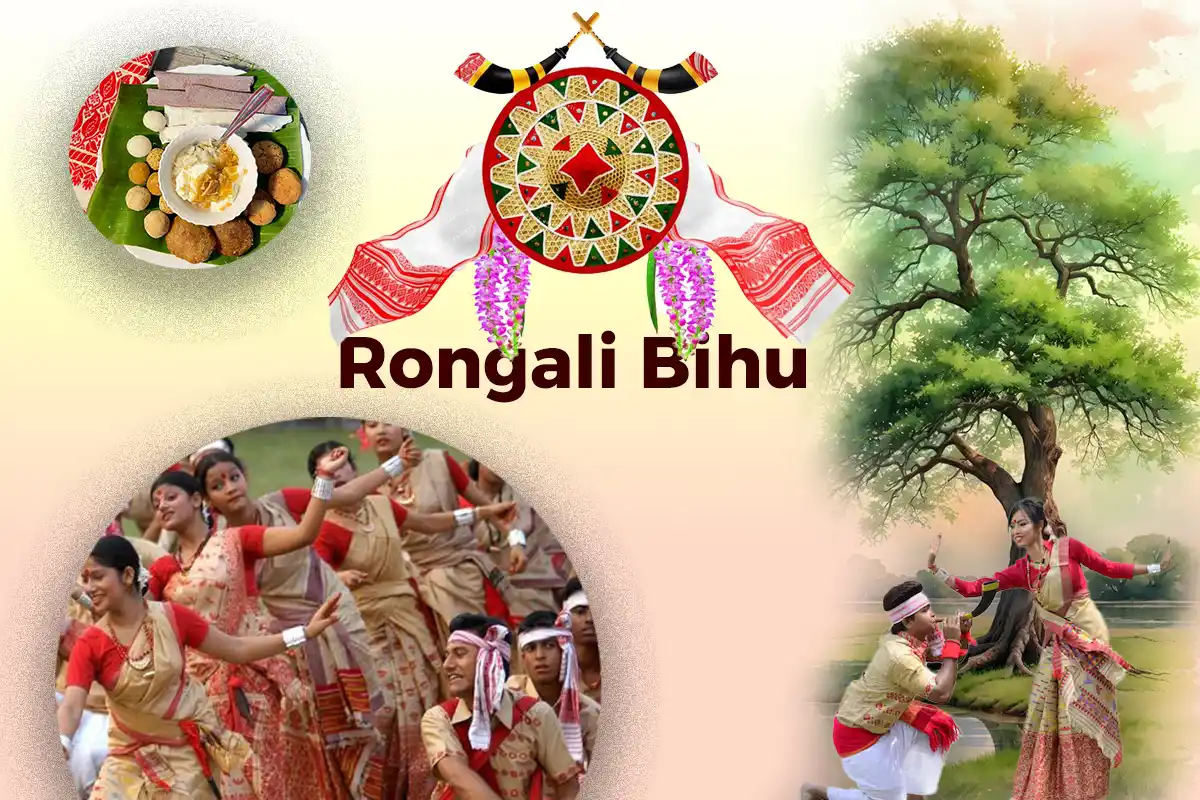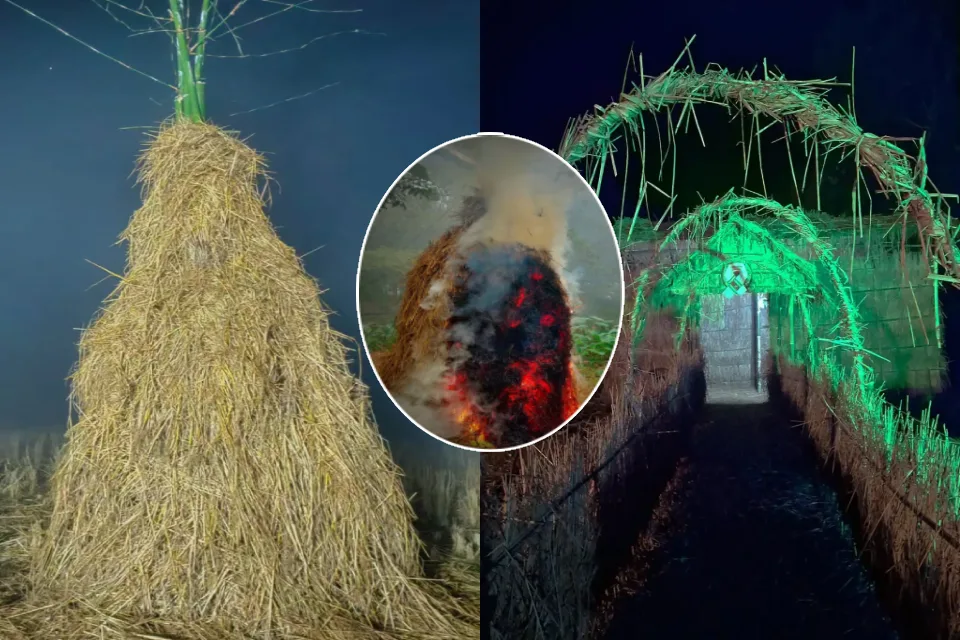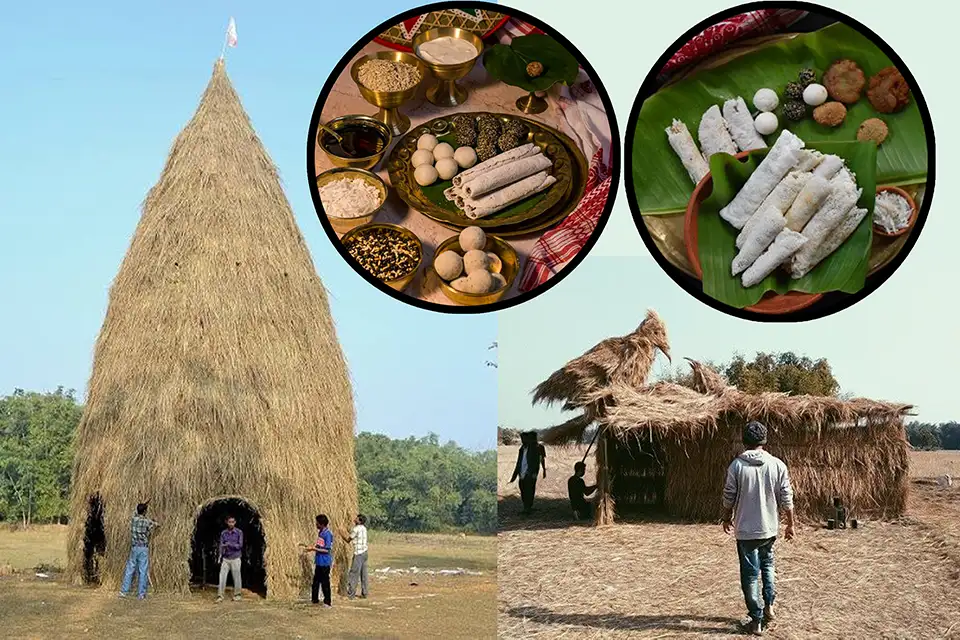Let’s catch the vibe of Rongali Bihu 2025 with vibrant cultural activities and move along the rhythm of nature in the glorious spring in Assam.
Updated on :
Share this post
Rongali Bihu, or Bohag Bihu, of Assam is celebrated during the month of April to welcome the Assamese new year. It’s a joyful celebration of dance, music, and cultural events, while offering gratitude to the elderly and everything that significantly contributes to a year’s survival.

Rongali Bihu marks the arrival of spring in Assam. Nature develops its own rhythm during this time, and all of its components work together to make the air in Assam lovely and joyous. From migratory singing birds to orchids in bloom, nature creates a beautiful backdrop that people enjoy through dance, music, and group activities.
Let’s have a look at the various activities that make Rongali Bihu so special
Glorious Rati Bihu and Jeng Bihu
Rati Bihu and Jeng Bihu can very well be regarded as a glorious tradition of Assamese culture. From prehistoric times till the mid-twentieth century, Rati Bihu and Jeng Bihu were held in the midst of nature in several villages in Assam’s Brahmaputra valley.
Since India’s independence, most villages have refrained from organizing such programs due to changes in sociocultural, educational, economic, political, and occupational circumstances. They are no longer held in the middle of nature but rather in a mimic form as part of the Rongali Bihu celebrations.
Rati Bihu and Jeng Bihu are also called Gostolor Bihu (Bihu beneath a tree), Bonor Bihu (Bihu of wilderness), and Maiki Bihu (Bihu of women). Both programs have been showcased at other cultural events both within and outside of the state, as well as worldwide, and have received high praise.
Rati Bihu
Rati Bihu was held under a tree or in the middle of a dense bamboo grove at night. The Assamese word for night is Rati, hence the name Rati Bihu. Rati Bihu of Rongali Bihu involves a group of elder boys and girls. The boys play instruments such as the dhol, taal, and pepa, while the girls play the gagana, tokka, and xutuli. Rati Bihu’s Bihunam, or songs, are generally romantic and sensual, but they also cover topics such as nature, culture, and lifestyle.
One of the unique elements of Rati Bihu’s Bihunaam is that boys and girls use songs to express their romantic feelings and answer romantic questions. When Bihunaam is performed in this fashion, it is known as Joranam. It made it easier for boys and girls to accept or reject romantic proposals. Historically, some couples married immediately after participating in Rati Bihu.
Also Read: Bhogali Bihu 2025: The Popular Harvest Festival of Assam
Jeng Bihu
Jeng Bihu was held during the daytime beneath a tree or in the midst of a dense area. During the Rongali Bihu, a group of grown-up girls perform the Bihu dance while singing and playing instruments such as the Gagana, Xutuli, and Toka. Toka is the primary instrument; hence it is also known as Toka Bihu and also as Gabhoru Bihu.
The name Jeng Bihu is derived from the Assamese word Jeng, which means dear girl or woman. There is no male participation or involvement. The Bihunam in Jeng Bihu are typically romantic but not sensual. Bihunam on subjects such as natural beauty, culture, lifestyle, livelihood, streams, and rivers is also often sung.
Hunchari
“দেউতাৰ পদুলিত গোন্ধাইছে মাধুৰী, কেতেকী মলে মলাই ঐ গোবিন্দাই ৰাম I দেউতা ঐ ঘূৰি আহি পালেহি চ’ত আপোনাৰ চোতালত হুঁচৰি আহিছো আপুনি আছেহি ক’ত ?”
Hunchari is the most systematic and disciplined program of Rongali Bihu in which Bihunach and Bihunam are performed with musical instruments. It is not only a program of entertainment but also of spiritual importance.
Mangaldhani is the most prominent component of it. The Hunchari party ushers a specific spiritual hymn while entering a household’s courtyard, thereby worshiping God and blessing the family with all-round prosperity. The second portion is referred to as Hunchari-Diha. Here, the group does a specific style of Bihunach by marching in a circle with specific steps. Bihunam compositions are typically about culture, festivals, mythological legends, and historical occurrences.
The final element is Bihu, which is the most thorough and entertaining component. The Hunchari-dal performs the energetic Bihu dance with numerous instruments before moving on to the last section, known as Ashirbad. The family shows reverence, and the party bestows blessings on the family. Previously, only men participated, but both genders now participate equally.
Bihunam
“Kolponar xagorot o moina, furu nu ooti bhahi, turei nu kotha bhabi Doloni potharot hai oi jaan oi, joronu moi mohore haal”
Bihunam, also known as Bihugeet, are the quintessential songs of Rati Bihu, Jeng Bihu, and Hunchari. Of course, love songs make up the majority of the Bihunaam, but some of them are quite sensual. Additionally, there are Bihunam on every facet and component of Assam’s abundant natural environment.
Additionally, there are Bihunam that depict many things, activities, and problems associated with the Assamese agrarian community. The composition of most of the Bihunam is of Dulari-Chandra. The fundamental manner of singing Bihunam in Rati Bihu and Jeng Bihu is to continuously sing multiple verses in clusters, whereas Jatnam is a style of singing that involves singing several rounds of a selected piece called Jat.
Joranam expresses love between a boy and a girl through verse, while Malita sings a combination of multiple verses that tell a story or explain an exciting incident. Bihunam of Rongali Bihu is typically sung in a rhythm known as Duchaparia-chapari, which translates to two successive hand claps.
Bihunach
Bihunach is the original dance form of Rongali Bihu and Assamese culture. Bihunach is done to the same Duchaparia-chapari rhythm as Bihunam. It sets it apart from other folk dancing forms. Bihunach expresses both the visible and inner beauty of the performer.
They express emotions such as joy, love, delight, and thrill through their dancing at Rongali Bihu. Furthermore, they remain smiling throughout the performance. Another notable element of Bihunach is the genuine smile and expression of joy in the face, notably in the eyes and lips, as well as the fact that none of the positions reflect any specific meaning.
The female dancers wear Muga Riha, Mekhela, and blouse and traditional Assamese jewelry. They adorn their hair with Kopouphul (Foxtail orchid). The men wear a dhoti, Muga shirt, Bihuwan, and Tongali.
Bihutoli Programs of Rongali Bihu

Currently, Rongali Bihu is celebrated with cultural events that last one to three days. During the month of Bohag, hundreds of such cultural events are held in various parts of the state, including both urban and rural areas. These cultural functions are known by numerous names, including Bihutoli, Bihu-mela, Basanta-utsav, and Bihu-sanmilan.
Various cultural programs held in present-day Bihutoli are Bihu competitions, showcasing of Hunchari, Jeng Bihu, Bihunach, and Oja dhol-badan, traditional dance and music of ethnic groups, and celebrity artist performances on modern Assamese songs and modern Bihugeet with western musical instruments. Furthermore, seminars, lectures, and discussion sessions about Bihu culture are also organized.
Types of Bihutoli
Bihutoli with stage
The majority of stage-based Bihutoli organize two or three types of programs during Rongali Bihu, with celebrity artist performances currently being the most popular. Programs like Bohagi adoron and Bohagi bidai are widespread.
Mukoli-Bihutoli
Such a Bihutoli is set up in an open field without a stage. Only traditional activities such as Hunchari, Jeng Bihu, and Bihunach are scheduled here, with no programs using modern music or instruments. They are less than the stage-based Bihutoli and are generally held in villages.
Bihu competitions
Bihu competitions have been playing a pivotal role in the preservation and practice of the traditional forms of Bihunach, Bihunam, Jeng Bihu, and Hunchari. Bihunach is mostly a group dance, but a new type of Bihu competition, known as Bihuwati, was set up recently at Rongali Bihu celebrations that is more individualistic in spirit. In a Bihuwati competition, just one Bihuwati, or female dancer, performs Bihunach while singing Bihunam and playing various instruments.
A group of male musicians and singers provides backup. The reward is only granted to Bihuwati. The various competitions held during Rongali Bihu are the Bihu Hunchari competition, Bor Bihuwati, Mou Kuwori, Bihu Samragi, Bihu Kuwori, and Bihu Rani competitions.
Cuisines of Rongali Bihu
Rongali Bihu festivities demand that traditional meals be prepared and shared with family, friends, and neighbors, ranging from pitha to protein-rich dishes. Bihu is also a celebration in Assam that welcomes the monsoon in April. Pitha of many types, such as narikal pitha (made with coconut), til pitha (made with sesame seeds), tekeli pitha, and others, are prepared specifically for feasts.
During Rongali Bihu, folks prepare a special delicacy called 101 herbs. The Assamese believe that the herbs used to prepare this dish have therapeutic properties that help enhance the immune system. People hunt local woodlands for these plants to use in traditional recipes.
There is also a tradition of making red ant dish, known locally as amralu poruar toop, at home for the Rongali Bihu celebration. Another food cooked on this day is Chaator torkari, which is a type of mixed vegetable made by cooking all of the veggies that were previously fed to the cows on Goru Bihu.
As celebrity chef Atul Lahkar said, “In a world where modern diets often prioritize convenience over nutritional value, the traditional practices of Assamese cuisine serve as a reminder of the wisdom inherent in eating according to the rhythms of nature.”
N.B.: To write this article, the book Bihu Festivals : All-inclusive elucidations by Dr. Pradip Neog has been taken as a reference for research and knowledge hunting. So, I would like to express my gratitude and thankfulness to the author.



